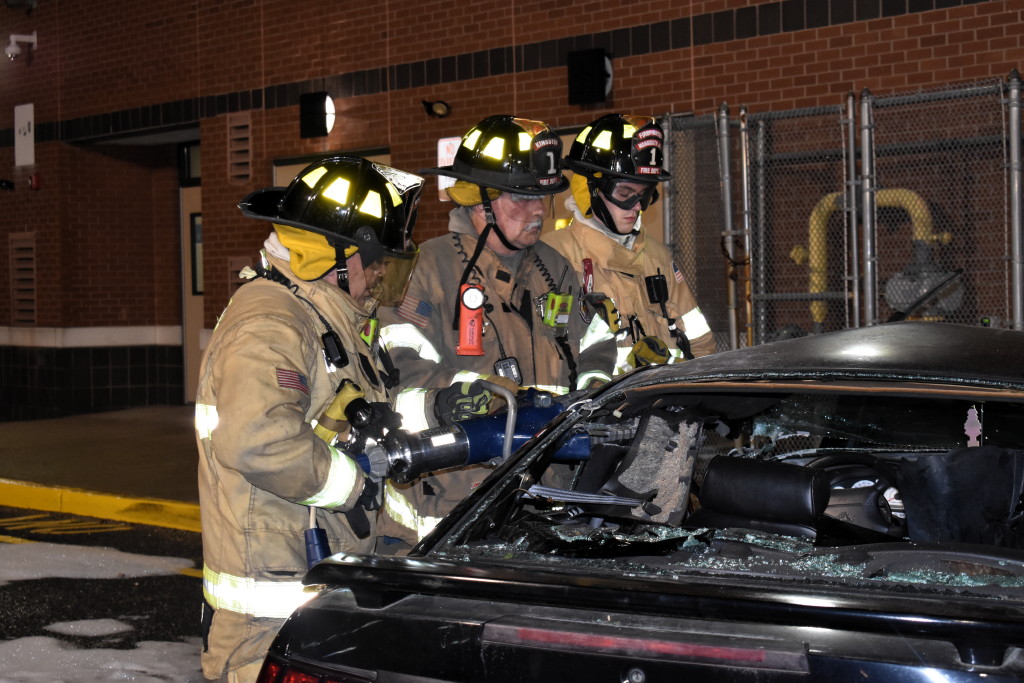SOUTH BRUNSWICK – Brooks Crossing Elementary School Head Custodian Helen Beecher did not sound too panicked when she alerted her principal to a crashing sound outside the building on Sept. 25.
However, around 1 p.m., while school was in session, Beecher said she began to smell natural gas after the crash.
After alerting Principal Jaime Maccarone, Beecher fell unconscious.
Maccarone immediately began an emergency response.
Police cars, firetrucks and EMS vehicles began arriving at the South Brunswick school, located on Deans Rhode Hall Road. Police officers were the first to observe a black Ford Mustang against the far wall of the school building, which ruptured a gas main.
Firefighters from the Kingston, Kendall Park and Monmouth Junction volunteer companies arrived to put out the car on fire and monitor the gas leak.
EMTs from the Kendall Park and Monmouth Junction first aid squads tended to the injuries of victims from the Mustang and a van that had collided. There were extrications from the Ford performed by a team of firefighters.
They also had to assist the custodian who had passed out.
While firefighters combed the building and evacuated staff and students, after a shelter in place because of the leaking gas, a call went out for a fallen firefighter; backup stormed inside the school to remove him from the front lobby.
While everything transpired, police officers had to answer questions from the media and anxious parents.
Although the aforementioned scene was merely a township-wide emergency services drill coordinated by the South Brunswick Office of Emergency Management, where no one was injured, it served as training and preparation should something on a large scale occur in town.
“We are preparing; we try to prepare for anything,” Police Chief Raymond Hayducka said. “Anything can happen at any time. The more we train, the more we are better prepared to serve the community.”
The purpose was also to have all departments collaborating on scene.
“We always work together. Most incidents, we have interoperability and we are acting and working together,” Hayducka said. “These drills are very important for all our emergency services. You’d be surprised to know how often we are all coordinating.”
Beecher said although she acted her role and was “passed out” during the exercise, she was impressed by the communication she heard over her radio.
“It got pretty intense at one point because reality set in about, what if this really happened?” she said.
She explained that she was dragged out of her office, brought outside the school, was intubated, her vitals were taken, and then she was put on a stretcher and symbolically taken to Robert Wood Johnson University Hospital.
“When you really started hearing, “We’re missing kids, we need to evacuate’ .. it puts a shot of reality into it,” she said.
She said the EMS workers who tended to her were “fantastic” despite the fantasy play.
“They never left my side. They were really good,” she said.
Edward Rodriguez, of Kendall Park, played an art teacher during the drill. He did not hear the announcement over the public announcement system, but was told there was a shelter in place. He was then told by an official the class needed to evacuate.
Rodriguez said he is somewhat familiar with such operations since he worked as accountant and traveled with the United Nations to Somalia and other countries to do security and occupational safety.
He said if there were a true emergency at the school, “a sense of anxiety would just build up.”
He said although it felt like they were locked inside for more than an hour, in reality it was less than a half hour.
“Being in the room in the exercise, like real life, it felt longer,” he said.
Robert Cioffi, deputy chief of the Kendall Park Fire Company, and Sean Wert, deputy chief of the Monmouth Junction Fire Company, were pleased with the overall effectiveness of the simulation.
“Your instinct comes from training. You do enough of this, it comes natural to size up,” Wert said.
Cioffi said that although first responders were told of the initial set up, there were “curveballs” thrown in, such as the firefighter getting injured, reports that students were unaccounted for, and parents arriving on scene to locate their children.
“As things unfold and the different scenarios change minute by minute, you just react based on the training we have,” he said.
Overall, about 60 firefighters from the three volunteer companies responded to handle the car accident, gas leak, primary and secondary search, potential for fire, and rapid intervention.
Cioffi called it “organized chaos.”
“This is very important, especially in today’s world,” he said. “I think for South Brunswick, we do work well together.”
Contact Jennifer Amato at [email protected].

